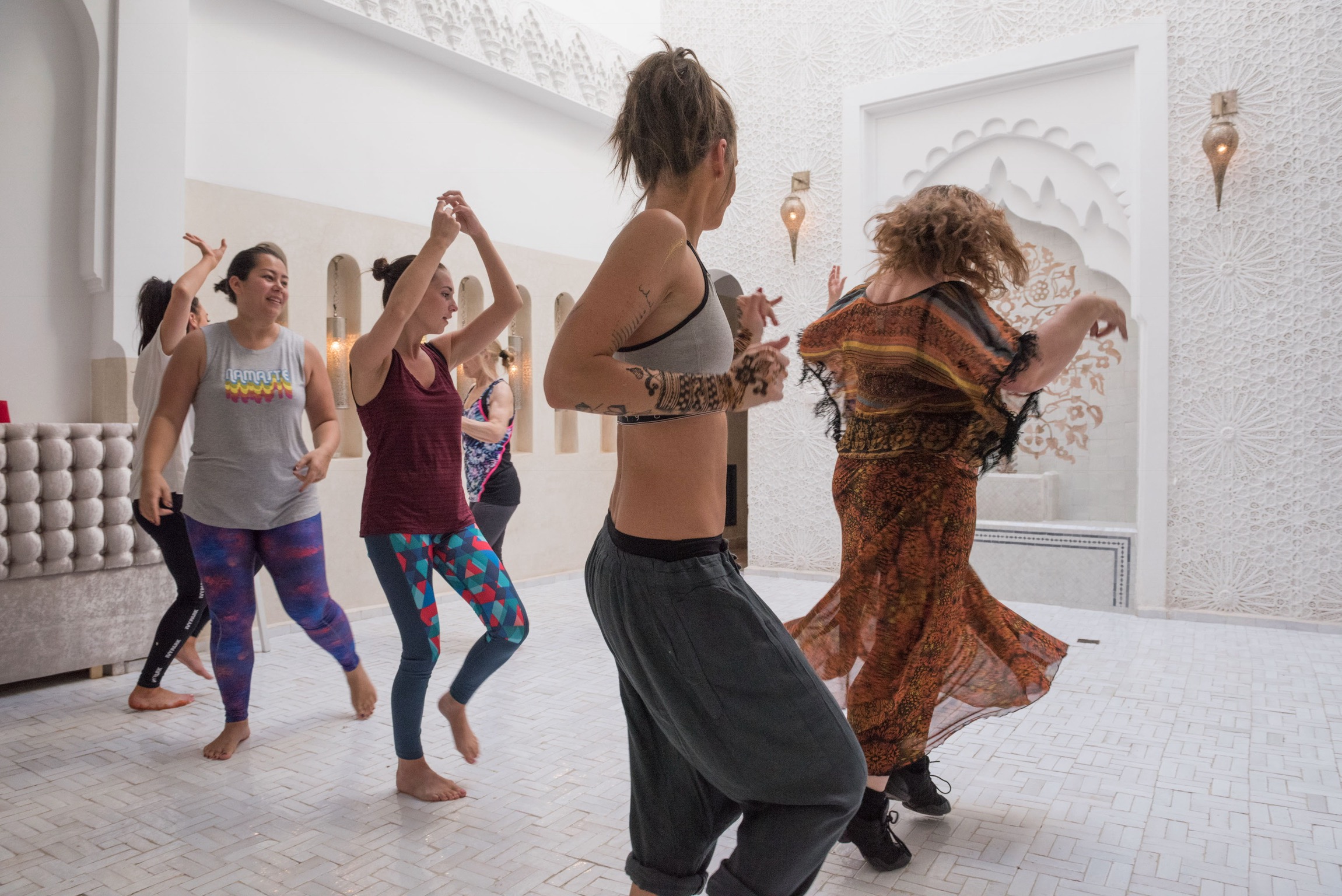There is a growing body of research on the benefits of dance for body, mind, and heart health. Studies have found that dancing has similar benefits to walking, but it burns more calories (Pate et al., 1995). Some of the specific findings on the benefits of dance include:
Body health:
- Improves posture and flexibility (Jeon et al., 2019)
- Increases aerobic strength (Koutedakis et al., 2005)
- Can reduce pain and stiffness (Kattenstroth et al., 2013)
- Helps improve balance and prevent falls (Hui et al., 2009)
- Improves cardiovascular health and makes us feel more energetic (Ravindran et al., 2019)
Happiness:
- Raises dopamine and serotonin, neurotransmitters responsible for feeling pleasure and happiness (Cotman et al., 2007)
- Creates the experience of flow with similar benefits to meditation (Kirschner et al., 2015)
- Eases anxiety, reduces stress and reduces depression (Fujii et al., 2014)
- Develops self-esteem and confidence (DiLorenzo et al., 2013)
Brain health:
- Sharpens the mind and may decrease the risk of dementia (Verghese et al., 2003)
- Helps develop new neural connections (Holmes and Calmels, 2008)
- Improves executive functions (Burzynska et al., 2017)
- Improves long-term memory and spatial recognition (Kattenstroth et al., 2010)
- Gives a feeling of accomplishment (Duberg et al., 2013)
Relationships:
- Builds social bonds and reduces social anxiety (Laroche and Korn, 2009)
- Improves social and communication skills (Finkbeiner et al., 2014)
In conclusion, dancing is a beneficial activity that can improve various aspects of physical, mental, and emotional health. It offers a wide range of benefits, from improving posture and flexibility to building social bonds and reducing stress and anxiety.
And most of all …….dancing is great fun!
Lucie offers Monthly Dance class “Dance like no one’s watching!” on zoom every 4th Thursday of the month from 07:00 PM -08.30 PM GMT. Bring a scarf, water, a mat or blanket and a journal or paper to write on.
You can join by using this link: Join Zoom Meeting: https://us02web.zoom.us/j/7879232516
If you are interested in joining us then please call 00 44 7971227338 or email lucieaw@yahoo.co.uk or simply head for the zoom link every 4th Thursday of the month at 7 pm.
References:
Burzynska, A. Z., Chaddock-Heyman, L., Voss, M. W., Wong, C. N., Gothe, N. P., Olson, E. A., … & Kramer, A. F. (2017). Physical activity and cardiorespiratory fitness are beneficial for white matter in low-fit older adults. PloS one, 12(10), e0186615.
Cotman, C. W., Berchtold, N. C., & Christie, L. A. (2007). Exercise builds brain health: key roles of growth factor cascades and inflammation. Trends in neurosciences, 30(9), 464-472.
DiLorenzo, T. M., Bargman, E. P., Stucky-Ropp, R., Brassington, G. S., Frensch, P. A., & LaFontaine, T. (2013). Long-term effects of aerobic exercise on psychological outcomes. Preventive medicine, 28(1), 75-85.
Duberg, A., Hagberg, L., Sunvisson, H., & Malmgren-Olsson, E. B. (2013). Influencing self-rated health among adolescent girls with dance intervention: a randomized controlled trial. Journal of School Health, 83(12), 824-832.
Finkbeiner, K. M., Carlson, M. C., Fried, L. P., & Rebok, G. W. (2014). Association between cognitive performance, physical fitness, and physical activity in older adults. Journal of Aging and Health, 26(5), 1-16. https://doi.org/10.1177/0898264314524065
Hui, E., Chui, B. T., & Woo, J. (2009). Effects of dance on physical and psychological well-being in older persons. Archives of gerontology and geriatrics, 49(1), e45-e50.
Jeon, M. Y., Park, S. H., Lee, D. H., & Lee, Y. J. (2019). Effects of Korean traditional dance on physical and psychological outcomes in elderly women. Journal of physical therapy science, 31(5), 432-435.
Kattenstroth, J. C., Kalisch, T., Peters, S., Tegenthoff, M., & Dinse, H. R. (2010). Long-term sensory stimulation therapy improves hand function and restores cortical responsiveness in patients with chronic cerebral lesions. Three single case studies. Frontiers in neuroscience, 4, 63.
Kattenstroth, J. C., Kolankowska, I., Kalisch, T., & Dinse, H. R. (2013). Superior sensory, motor, and cognitive performance in elderly individuals with multi-year dancing activities. Frontiers in aging neuroscience, 5, 4.
Kirschner, S., Kaminski, E., & von Steinbüchel, N. (2015). Improving cognitive performance in elderly subjects by means of rhythm and music. Advances in gerontology, 5(4), 276-282.
Laroche, D. P., & Korn, H. J. (2009). Influence of social support on adaptation to dance for adults with arthritis. American journal of dance therapy, 31(1), 25-41.
Pate, R. R., Pratt, M., Blair, S. N., Haskell, W. L., Macera, C. A., Bouchard, C., & King, A. C. (1995). Physical activity and public health: a recommendation from the Centers for Disease Control and Prevention and the American College of Sports Medicine. Jama, 273(5), 402-407.
Ravindran, R., Rathbone, J., & Santesso, N. (2019). Exercise for depression. Cochrane Database of Systematic Reviews, (9).
Verghese, J., Lipton, R. B., Katz, M. J., Hall, C. B., Derby, C. A., Kuslansky, G., … & Buschke, H. (2003). Leisure activities and the risk of dementia in the elderly. New England Journal of Medicine, 348(25), 2508-2516.

